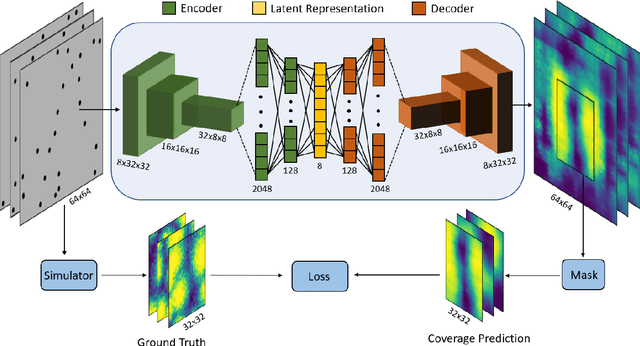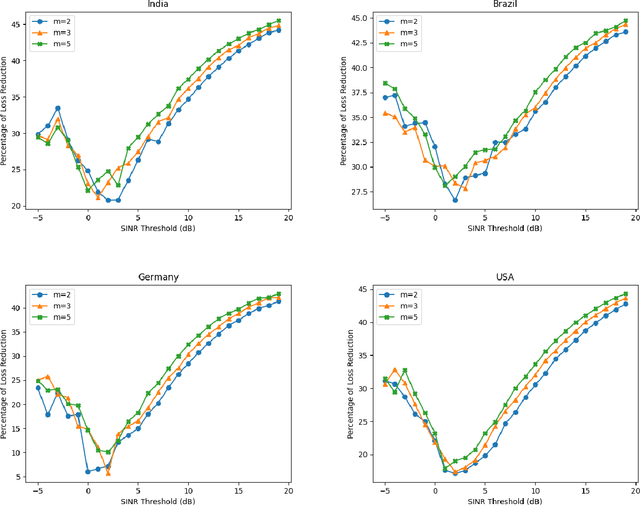Praful D. Mankar
Near-field 5D Pose Estimation using Reconfigurable Intelligent Surfaces
May 03, 2025Abstract:The advent of 6G is expected to enable many use cases which may rely on accurate knowledge of the location and orientation of user equipment (UE). The conventional localization methods suffer from limitations such as synchronization and high power consumption required for multiple active anchors. This can be mitigated by utilizing a large dimensional passive reconfigurable intelligent surface (RIS). This paper presents a novel low-complexity approach for the estimation of 5D pose (i.e. 3D location and 2D orientation) of a UE in near-field RIS-assisted multiple-input multiple-output (MIMO) systems. The proposed approach exploits the symmetric arrangement of uniform planar array of RIS and uniform linear array of UE to decouple the 5D problem into five 1D sub-problems. Further, we solve these sub-problems using a total least squares ESPRIT inspired approach to obtain closed-form solutions.
RIS-NOMA integrated low-complexity transceiver architecture: Sum rate and energy efficiency perspective
Feb 07, 2024



Abstract:This paper aims to explore reconfigurable intelligent surface (RIS) integration in a millimeter wave (mmWave) communication system with low-complexity transceiver architecture under imperfect CSI assumption. Towards this, we propose a RIS-aided system with a fully analog (FA) architecture at the base station. However, to overcome the disadvantage of single-user transmission due to the single RF-chain, we employ NOMA. For such a system, we formulate sum rate (SR) and energy efficiency (EE) maximization problems to obtain the joint transmit beamformer, RIS phase shift matrix, and power allocation solutions under minimum rate constraint. We first tackle the fractional objectives of both problems by reformulating the SR and EE maximization problems into equivalent quadratic forms using the quadratic transform. On the other hand, we employ successive convex approximation and the semi-definite relaxation technique to handle the non-convex minimum rate and unit modulus constraint of the RIS phase shifts, respectively. Next, we propose an alternating optimization-based algorithm that iterates over the transmit beamformer, power allocation, and RIS phase shift subproblems. Further, we also show that the quadratic reformulation is equivalent to the WMSE-based reformulation for the case of SR maximization problem. Our numerical results show that the proposed RIS-NOMA integrated FA architecture system outperforms the optimally configured fully digital architecture in terms of SR at low SNR and EE for a wide range of SNR while still maintaining low hardware complexity and cost. Finally, we present the numerical performance analysis of the RIS-NOMA integrated low-complexity system for various system configuration parameters.
Maximum Eigenvalue Detection based Spectrum Sensing in RIS-aided System with Correlated Fading
Nov 14, 2023Abstract:Robust spectrum sensing is crucial for facilitating opportunistic spectrum utilization for secondary users (SU) in the absense of primary users (PU). However, propagation environment factors such as multi-path fading, shadowing, and lack of line of sight (LoS) often adversely affect detection performance. To deal with these issues, this paper focuses on utilizing reconfigurable intelligent surfaces (RIS) to improve spectrum sensing in the scenario wherein both the multi-path fading and noise are correlated. In particular, to leverage the spatially correlated fading, we propose to use maximum eigenvalue detection (MED) for spectrum sensing. We first derive exact distributions of test statistics, i.e., the largest eigenvalue of the sample covariance matrix, observed under the null and signal present hypothesis. Next, utilizing these results, we present the exact closed-form expressions for the false alarm and detection probabilities. In addition, we also optimally configure the phase shift matrix of RIS such that the mean of the test statistics is maximized, thus improving the detection performance. Our numerical analysis demonstrates that the MED's receiving operating characteristic (ROC) curve improves with increased RIS elements, SNR, and the utilization of statistically optimal configured RIS.
Optimal Beamforming and Outage Analysis for Max Mean SNR under RIS-aided Communication
Nov 17, 2022Abstract:This paper considers beamforming for a reconfigurable intelligent surface (RIS)-aided multiple input single output (MISO) communication system in the presence of Rician multipath fading. Our aim is to jointly optimize the transmit beamformer and RIS phase shift matrix for maximizing the mean signal-to-noise (SNR) of the combined signal received over direct and indirect links. While numerical solutions are known for such optimization problems, this is the first paper to derive closed-form expressions for the optimal beamformer and the phase shifter for a closely related problem. In particular, we maximize a carefully constructed lower bound of the mean SNR, which is more conducive to analytical treatment. Further, we show that effective channel gain under optimal beamforming follows Rice distribution. Next, we use these results to characterize a closed-form expression for the outage probability under the proposed beamforming scheme, which is subsequently employed to derive an analytical expression for the ergodic capacity. Finally, we numerically demonstrate the efficacy of the proposed beamformer solution in comparison with the existing algorithmically obtained optimal solution for the exact mean SNR maximization.
Deep Learning based Coverage and Rate Manifold Estimation in Cellular Networks
Feb 13, 2022



Abstract:This article proposes Convolutional Neural Network-based Auto Encoder (CNN-AE) to predict location-dependent rate and coverage probability of a network from its topology. We train the CNN utilising BS location data of India, Brazil, Germany, and the USA and compare its performance with stochastic geometry (SG) based analytical models. In comparison to the best-fitted SG-based model, CNN-AE improves the coverage and rate prediction errors by a margin of as large as $40\%$ and $25\%$ respectively. As an application, we propose a low complexity, provably convergent algorithm that, using trained CNN-AE, can compute locations of new BSs that need to be deployed in a network in order to satisfy pre-defined spatially heterogeneous performance goals.
Adaptive Rate NOMA for Cellular IoT Networks
Aug 18, 2021Abstract:Internet-of-Things (IoT) technology is envisioned to enable a variety of real-time applications by interconnecting billions of sensors/devices deployed to observe some random physical processes. These IoT devices rely on low-power wide-area wireless connectivity for transmitting, mostly fixed- but small-size, status updates of their associated random processes. The cellular networks are seen as a natural candidate for providing reliable wireless connectivity to IoT devices. However, the conventional orthogonal multiple access (OMA) to these massive number of devices is expected to degrade the spectral efficiency. As a promising alternative to OMA, the cellular base stations (BSs) can employ non-orthogonal multiple access (NOMA) for the uplink transmissions of mobile users and IoT devices. In particular, the uplink NOMA can be configured such that the mobile user can adapt transmission rate based on its channel condition while the IoT device transmits at a fixed rate. For this setting, we analyze the ergodic capacity of mobile users and the mean local delay of IoT devices using stochastic geometry. Our analysis demonstrates that the above NOMA configuration can provide better ergodic capacity for mobile users compare to OMA when IoT devices' delay constraint is strict. Furthermore, we also show that NOMA can support a larger packet size for IoT devices than OMA under the same delay constraint.
 Add to Chrome
Add to Chrome Add to Firefox
Add to Firefox Add to Edge
Add to Edge